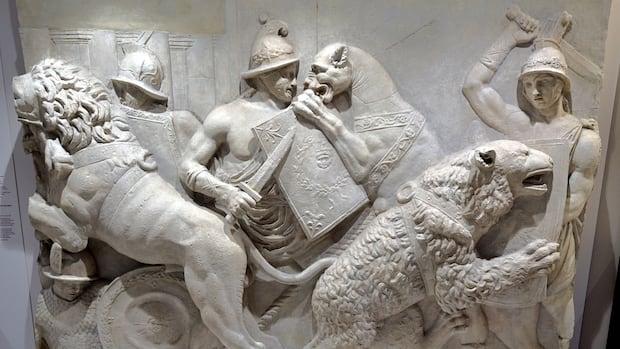As It Happens6:16Did Roman gladiators really fight animals? This one has the bite marks to prove it
In one ancient battle between man and beast, it appears the beast reigned supreme.
Researchers have identified bite marks, most likely from a lion, on the pelvis of a man buried in what is believed to be a cemetery for ancient Roman gladiators in England.
This may not seem surprising to anyone who’s studied ancient Roman texts, or even watched a modern gladiator movie, both of which depict a society that pitted men against animals for bloodsport.
But the authors of a new study say these bite marks are, in fact, the first known physical evidence of human-animal combat in ancient Roman times.
“We certainly have within our kind of cultural understanding the sense of gladiator combat, and that gladiators fight each other and were fighting big animals all the time,” lead author Tim Thompson, a forensic anthropologist at Maynooth University in Ireland, told As It Happens host Nil Kӧksal.
“Actually, the evidence for that is scant. This is the first time that we’ve actually found physical evidence on a body.”
The findings were published in the journal PLOS One.
Who was he, and how did he die?
The remains were excavated about 20 years ago near the English city of York, or as it was known during the Roman Empire, Eboracum.
They belong to a man in his late twenties or early thirties who lived during the 3rd century AD, when Eboracum was an important town and military base in the north of the Roman province of Britannia.
The researchers suspect he was a gladiator because he was found at a gravesite alongside many other men, all killed over the course of several generations, all decapitated just before or after their deaths, and most bearing signs of repeated physical trauma from fighting.
The tooth marks were found on both of his hips, Thompson says, suggesting that whatever bit him “really kind of grabbed onto that pelvis.”
The “unusual” placement of the bite mark, he says, suggests it was not the killing blow.
“I’m going to paint a slightly grim image of what may have happened to this poor individual,” Thompson said.
The man, he says, was probably already incapacitated during the bloody battle by bites that tore through his flesh, but didn’t leave marks on his bones.
“Then what the lion has done is bitten him on his hip and dragged that body away … to scavenge and eat the remains,” he said.
The body was also decapitated, Thompson said, sliced through the neck from the back to the front. This could have been an execution, or the coup de grace after injury and defeat in the arena.
“But that, for sure, is the last blow that occurred to the body,” Thompson said.
Ancient Romans were into ‘pretty gory things’
To identify the tooth marks, Thompson and his colleagues made a 3D model of them, and compared it with bite marks left by various large animals at a zoo.
“For sure we can say it’s a big cat, a big animal. We think it is most likely to be a lion,” he said.
Seth Bernard, a professor of ancient history at the University of Toronto who was not involved in the study, said it’s really exciting to see physical evidence of a phenomenon historians have long known about from literature.
The role of animals in gladiator battles, he says, is well-documented.
Gladiator fights were a popular form of entertainment in ancient Rome, and the fighters were most often slaves, prisoners and, on occasion, volunteers.
There are murals and mosaics depicting gladiators in combat with various predators. Ancient poets, Bernard says, described “games where people are put to death through beast hunts, or re-enacting mythological scenes or pretty gory things.”
“These are people who, you know, on a Tuesday afternoon, when they want to go be entertained, they’re watching prisoners killed in the amphitheatre, or slaves killed in amphitheatres, by big beasts,” Bernard said.
There’s physical evidence of the creatures too. In 2022, archeologists found the bones of bears and big cats at the Colosseum in Rome.
The animals, often starved to make them more aggressive, were also pitted against each other, and often chained together, said study co-author John Pearce, a Roman archaeologist at King’s College London.
It wasn’t always a fight. Animals were were also used in executions, Pearce said, with their victims bound or otherwise defenceless.
“This is a reminder of the spectacle culture central to Roman public life,” he said.
The fact that these remains were unearthed near York paints a picture of just how far and wide the Roman Empire — and, with it, “the darker sides of Roman culture” — had spread, says Bernard.
“I mean, there are not many lions in England,” he said. “The transport of these animals has got to be pretty remarkable and striking. There are a lot of logistics that I think about.”
Thompson says the discovery makes him wonder what else archeologists might find among the remnants of far-flung Roman settlements.
“If they’ve taken a lion from North Africa to York, where else have they taken these big animals?” he said. “Maybe we need to look at some of these other big settlements as well for evidence of gladiator cemeteries.”
did-roman-gladiators-really-fight-animals-this-one-has-the-bite-marks-to-prove-it















Leave a Reply